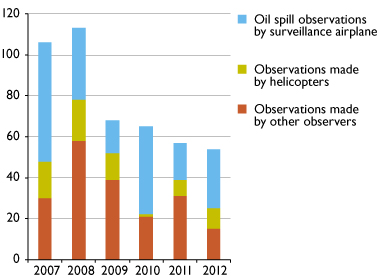Press release 2013-02-05 at 10:00
Press release by SYKE and the Finnish Border Guard
In 2012, the Finnish authorities detected 54 oil spills in the Baltic Sea, 47 of which were observed in the Finnish sea area, six in Estonia and one in Sweden. In addition to these, the Estonian authorities reported three oil spills in the Finnish sea area. As in previous years, most of the spills in the Finnish area were observed either in the ports or by the shoreline. Surveillance aircrafts detected several spills by the major shipping lanes.
The number of spills detected by the authorities has dropped by 50 per cent in six years, and the size of the spills has also reduced markedly. In 2012, the average volume of an oil spill was estimated at 25 litres compared to that of 170 litres in 2008.
|
Number of oil spills reported by Finland
|

|
|
|
Putting a stop to oil spills with effective surveillance and legislation
One of the likely reasons for the reduction in oil spills is a new law, which entered into force in 2006 and, compared to the normal criminal procedure, enabled faster imposition of administrative oil pollution fees on shipping companies or private individuals found guilty of oil spill offences. The amount of the fee depends on the volume of the spill and the size of the vessel. In 2012, the Finnish Border Guard investigated two oil spill incidents, eleven cases less than in 2017. The amount of a single oil pollution fee has been approximately EUR 10,000 over the last six years, and it seems that the fees have acted as a deterrent in Finland
The number of detected spills is in decline also elsewhere in the Baltic Sea. Effective aircraft surveillance in partnership with Finland's neighbouring countries has played a key role in reducing the number of spills. Regular surveillance flights on aircrafts fitted with environmental monitoring equipment have been carried out since the 1980s. Finland purchased surveillance aircrafts in mid-1990s. Despite a decline in spills, much remains to be done, as the Baltic Marine Environment Protection Commission (HELCOM) seeks to put a stop to oil spills in the Baltic Sea by 2021.
Resources continue to be earmarked for reducing oil spills
The upgrading of the surveillance equipment of the Finnish Border Guard's Dornier aircrafts, which began in 2009, will be completed in early 2013. Funded by SYKE, the upgrade began in 2009, when the planes were fitted with side-looking radars used for environmental surveillance, and equipment measuring the relative thickness of oil. The planes were also equipped with a facility to receive Automatic Identification System (AIS) data from vessels, and a satellite data transfer link. The second phase of the upgrade was carried out by the Finnish Border Guard, which purchased radars and infrared cameras for the planes. All aircraft equipment has now been integrated into a single surveillance system.
In addition to surveillance flights, oil spills in the Finnish area are monitored with the help of 250 satellite images every year. The satellite images are provided by the European Maritime Safety Agency (EMSA). With satellite images and surveillance flights, the sea areas can be monitored also at night and through cloud cover.
Regular (oil) pollution surveillance operations are also held in the Baltic Sea area. During these operations, continuous surveillance flights take place for a period of at least 24 hours over busy shipping lanes. The Finnish planes take an active part in such surveillance efforts.
Further information
Oil spill control
Kati Tahvonen, Senior Adviser, tel. +358 400 148 754
firstname.lastname@ymparisto.fi
Administrative oil pollution fees
Tom Lundell, Maritime Safety Expert, Finnish Border Guard,
tel. +358 40 521 4685, firstname.lastname@raja.fi